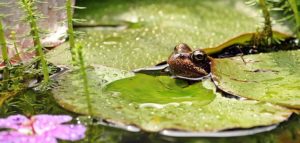Sitting in my office feeling hot and flustered! A visit to our local pool, a cold shower or an ice-cold drink will certainly help cool me down. But what about our local wildlife? – how do they survive this heatwave we are experiencing. The lawns are looking parched, plants wilting and ground is bone-dry. Garden ponds are a stark contrast to the bleakness this heatwave has created. Not only do they add colour and vibrancy, but a pond is extremely helpful to birds, bees, dragonflies, frogs, newts, hedgehogs and many other creatures – attracting them into the garden.
Benefits of a garden pond to wildlife
- Aquatic plants grown in and around a pond provide a landing place for bees, butterflies and dragonflies so that they can drink the water
- Aquatic plants provide nectar for pollinators, adds colour to a garden without having to be watered and they offer shelter to many small creatures
- Provides water to thirsty wildlife and a cool place to escape the heat
- Attract dragonflies which in turn feed on mosqitoes
- Ponds use less water than having to nurture flowerbeds and lawn in hot, dry conditions
- Don’t require fertiliser or pesticides to keep them looking good so are an environmentally favourable addition to any size garden
- Helps prevent frog and toad population numbers declining

A garden pond helps local ecosystems so that we can continue enjoying their sounds and sightings. As Dr Daniel Hayhow, RSPB conservation scientist said: “Unfortunately, the sights and sounds of wildlife that were once common to us are sadly becoming more mysterious. Creating a small pond in your garden, or a pool using a washing-up bowl, is so simple to do and could make all the difference.”
How to build a wildlife friendly pond
- Make your pond as big as possible to create many and varied habitats. The Wildlife Trust suggests a pond 1m wide by 2m long to be an ideal size
- Ensure some edges are shallow and sloping to allow creatures easy access
- Add aquatic plants
When you have finished building your pond don’t be tempted to transfer creatures such as frogs and newts from other ponds or take spawn from the wild, which can spread disease. Insects, amphibians and invertebrates will find your pond surprisingly quickly on their own.
Pond liners are an easy way of containing water for wildlife ponds particularly where the ground is porous. The pond liner does not need to detract from the natural look of your pond. Cover it with smooth surfaced pebbles. Rubber pond liners such as Epalyn (EPDM) or Butyl are non-toxic to wildlife and don’t leach chemicals into the water. These pond liners are thick, flexible and resistant to UV rays so will stand up to sunny, hot conditions and the presence of wildlife for more than 25 years.
Useful Articles:
26 Reasons why you should definitely build a pond for wildlife





